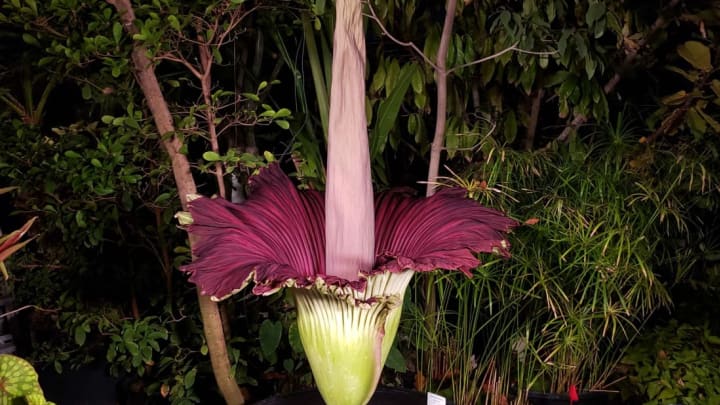If someone’s talking about a corpse flower, or Amorphophallus titanum, there’s a good chance they’ll end up mentioning one or all of these characteristics: It’s phallic, it smells atrocious, and it might only bloom about once a decade.
Earlier this week, Barnard College’s corpse flower unfurled for the first time ever, and you can watch its slow progress in real time on the YouTube livestream below. This particular specimen was given to Barnard’s Arthur Ross Greenhouse by the Brooklyn Botanic Garden Horticulture Department in 2013, and it’s named “Berani,” after the Indonesian word for brave—a nod to the species’s native region of Sumatra, Indonesia.
In previous years, the greenhouse staff has watched the potato-like tuber sprout into a tall, leafy structure—each taller than the last, with the most recent one measuring about 12 feet—hoping that next time, they’d get to watch it blossom into a flower instead. When Berani began to shoot up again this spring, they noticed it looked different, and by the time it was nearly 3 feet tall, they could confirm that the swollen spathe would soon unsheath a beautiful, putrid flower.
Since the coronavirus pandemic prevented them from inviting the public to see Berani blossom in person, greenhouse administrator Nick Gershberg and his colleagues have documented the process on the greenhouse’s Instagram account (as well as the livestream), and they’re planning to release a time-lapse video soon.
Gershberg tells Mental Floss that the flower reached its peak on Sunday night, May 31, at which point it measured 72 inches tall and 44 inches wide. And, true to its reputation, the corpse flower filled the room with a heavy stench that initially smelled like a dead rat. As the flower heated itself up to a temperature about 12 degrees warmer than the room—a respiration process called thermogenesis—Gershberg detected other recognizable scents, including dead fish, Camembert cheese that’s been left out overnight, and the odor of slightly decayed lilies. After the flower’s temperature came back down, it settled into a much more pleasant smell: a freshly-gutted pumpkin.
The corpse flower gets its name because its odor is often compared to that of a corpse, but Gershberg’s experience suggests that the association might be more in our heads than anything else.
“It was only when I went on the mental expedition of happening upon [the smell] in a jungle and thinking, ‘Oh my god, that’s a dead body,’ that it was actually nauseating. At that point, it was very nauseating,” he explains. “But as soon as I stopped thinking about it as, like, ‘Oh this is a dead body, or maybe dead person, even,’ then it didn’t have that effect. So it was interesting to see how in the face of this extreme odor, so much of it was really psychological, as far as whether I thought it was a good smell or a bad smell.”
Since a corpse flower only blooms for about 48 hours, Berani will soon begin to wither, and it’ll eventually fall over and separate from its base. After the roots die, the only thing left will be what Gershberg describes as “a 40-pound, beach ball-sized potato.” The team will remove it from the pot, clean it, inspect it for any infections, replant it, and wait for the now-dormant tuber to send up a new leaf, which will likely happen sometime in the next three to six months.

According to Gershberg, the experience of seeing the corpse flower bloom in all its majestic glory fundamentally changes how you view its usual tuber and leaves.
“It’s like when you see someone do karaoke and you’re like, ‘My god, that person can really sing,’ and you never quite look at them the same way again,” he says. “You’re like, ‘There’s actually a superstar in that head of accounting over there.’”
To help them remember just how big of a superstar Berani really is—and give the public a chance to see it for themselves in the future—the Barnard team is hoping to preserve some of it as a flower pressing. While you’re waiting to see what that looks like, you can learn more about corpse flowers here.
